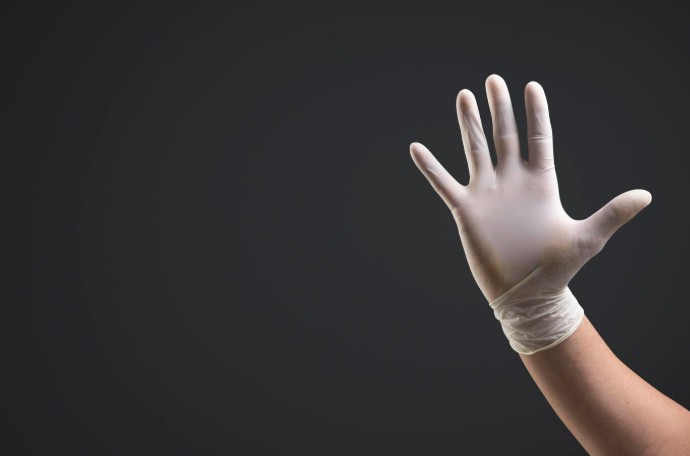Can static electricity be prevented by latex examination hand gloves? Find out here

Static electricity is a natural phenomenon that can lead to significant challenges, especially in environments where precision, hygiene, and safety are essential. Whether it is in medical settings, laboratories, electronic industries, or cleanrooms, the buildup and sudden discharge of static electricity can result in product contamination, damage to sensitive electronic components, and even pose a risk to personal safety. One of the protective measures considered in such environments is the use of latex examination hand gloves. But can latex gloves truly prevent static electricity? This is a question worth exploring in depth. Understanding how static electricity works and how various materials, including latex, interact with it is key to addressing this concern.
RH Healthcare, a trusted Latex examination hand gloves wholesaler in Gandhinagar, has long been supplying gloves designed to provide comfort, barrier protection, and, in some applications, electrostatic dissipation. However, the effectiveness of latex gloves in preventing static depends on several factors, such as the glove’s material composition, surface resistance, and the specific environment in which it is used. In this detailed blog, we will uncover the science behind static electricity, its risks, how latex gloves function, and whether they are a viable solution in electrostatic-sensitive settings. Let us explore the answers below.
Static Electricity: What is it, and Why Does it Matter?
Static electricity occurs when there is an imbalance of electric charges within or on the surface of a material. These charges remain static until they are released, usually in the form of a small shock when contact is made with another conductive object. In everyday life, this can be experienced when walking across a carpet and touching a doorknob. While often harmless, in technical environments, the same principle can be dangerous.
In medical and electronic manufacturing fields, static discharge can:
- Interfere with sensitive equipment
- Damage electronic circuitry
- Attract dust or contaminants
- Create flammable sparks in sensitive environments
Why Is Static Electricity a Concern in Clinical and Industrial Environments?
While static shocks might be considered a mere inconvenience in casual settings, their implications in sterile or electronic-focused industries are far more serious. In hospitals, for instance, static buildup can attract airborne particles that may contaminate a sterile field. In the semiconductor or electronics industry, a tiny static spark can damage integrated circuits, which are often sensitive to even minute electrostatic discharge (ESD).
The real concern in these environments revolves around Electrostatic Discharge (ESD). This sudden transfer of static charge can:
- Corrupt digital data
- Cause unexplained failures in electronic devices
- Ruin microchips and sensors
- Increase maintenance and operational costs
- Endanger personnel safety in environments with flammable substances
This explains the emphasis on using materials and protective gear that are either conductive or capable of dissipating static charges effectively.
What Are Latex Examination Hand Gloves?
Latex examination gloves are made from natural rubber latex, a biodegradable material derived from the sap of rubber trees. These gloves are widely used in the healthcare sector due to their elasticity, barrier protection, tactile sensitivity, and comfort.
Common characteristics of latex gloves include:
- High level of flexibility and comfort
- Resistance to certain chemicals
- Tight fit offering precise control
- Effective microbial barrier
However, not all latex gloves are created equal, especially when it comes to static protection. Standard latex gloves are primarily designed to offer protection against biological hazards, not to conduct or dissipate static charges. This is where the real distinction needs to be made.
Do Latex Gloves Conduct Electricity?
Latex as a material is generally considered an electrical insulator. That means it resists the flow of electricity rather than conducts it. In reality, static electricity is not about the conduction of electricity but rather about the accumulation and sudden discharge of electric charge. Since latex is an insulator, it does not allow charges to pass through, but it also does not allow them to dissipate effectively. This means static charges can build up on the surface of latex gloves without being grounded.
Therefore, the simple presence of latex gloves does not guarantee static protection. In fact, in some situations, gloves can contribute to static buildup rather than prevent it.
When Can Latex Gloves Cause More Harm Than Good in Static-Sensitive Zones?
In environments like semiconductor cleanrooms or explosive chemical storage areas, the use of the wrong type of gloves can increase risks. Latex gloves may increase electrostatic charges when combined with other insulating clothing or flooring materials.
Some potential drawbacks of using standard latex gloves in static-sensitive areas include:
- Accumulation of static on glove surface
- Inability to ground or dissipate charges
- Increased risk of accidental ESD discharges
- Attraction of dust and particles due to surface charge
This does not mean latex gloves should never be used—it means they should be used with caution and in the right applications.
Are There ESD-Safe Latex Gloves?
Yes. Manufacturers like RH Healthcare understand the limitations of traditional latex gloves and offer specialized latex examination gloves that are manufactured with antistatic properties. These gloves are designed with controlled surface resistance to reduce static buildup.
These specially formulated gloves are tested for:
- Electrostatic discharge performance
- Surface resistance
- Compatibility with sensitive environments
They are commonly used in cleanrooms, pharmaceutical manufacturing, aerospace, and electronics industries, where ESD control is critical. Not every latex glove is antistatic, so it is important to differentiate and select gloves based on the specific need.
Comparing Latex Gloves With Other Glove Materials for Static Protection
It is also important to compare latex gloves with alternatives like nitrile or vinyl when assessing static safety:
- Nitrile Gloves: More chemically resistant and often less static-prone. Some nitrile gloves are ESD safe and used in cleanrooms.
- Vinyl Gloves: Low cost but offer poor fit and protection. Limited use in static-sensitive environments.
- Antistatic-Coated Gloves: These gloves, regardless of material, include a coating or are manufactured to reduce surface resistance.
Latex gloves may still be suitable for environments requiring tactile sensitivity and a biological barrier but must be antistatic rated if static control is needed.
How to Identify Latex Gloves That Are Safe for Electrostatic Environments
When choosing latex gloves for environments where static discharge is a concern, consider the following:
- Check if the glove is ESD certified or has undergone static dissipative testing.
- Verify the surface resistance range is appropriate (between 10⁵ and 10¹¹ ohms for ESD-safe gloves).
- Prefer gloves from a trusted wholesaler like RH Healthcare that provides clear documentation and testing compliance.
- Understand glove use in the broader PPE setup (e.g., antistatic gowns, grounded mats, ionizers).
Gloves should always be chosen in combination with other ESD-safe practices to ensure maximum protection.
RH Healthcare’s Role in Latex Glove Safety and Static Management
RH Healthcare, a leading provider of medical-grade and industrial-grade gloves, recognizes that different industries require different levels of protection. Their expertise in glove material science, quality control, and custom supply solutions allows them to cater to a variety of professional fields.
RH Healthcare focuses on:
- Manufacturing latex gloves with enhanced formulation
- Providing surface resistance data and ESD compliance documentation
- Maintaining consistency in thickness and comfort
- Distributing gloves suited for healthcare and sensitive industrial use
Their reputation as a Latex examination hand gloves wholesaler in Gujarat comes from years of reliable service and technical understanding of industry-specific requirements.
Use Cases Where Antistatic Latex Gloves Are Necessary
Some environments that commonly require antistatic or ESD-safe gloves include:
- Microelectronics and semiconductor labs
- Pharmaceutical packaging facilities
- Aerospace component manufacturing
- Medical labs with sensitive digital equipment
- Automotive assembly using computerized systems
- Chemical storage and mixing units
In these areas, the wrong glove can result in faulty products, unsafe operations, or costly downtime. This is why glove selection is not just about comfort or biological protection—but about holistic operational safety.
Myths and Misconceptions About Static and Gloves
It is easy to assume that wearing any glove will protect against static. This is one of the biggest misconceptions. In fact:
- Gloves may insulate but not dissipate static
- Powdered gloves can increase charge generation
- Gloves used without grounding or ionizers may cause more harm
- Only tested gloves with ESD properties are safe in critical environments
Understanding the distinction between insulating and dissipative materials is essential in making the right decision.
How to Reduce Static Electricity in the Workplace: A Broader Approach
Beyond glove usage, a complete approach to controlling static includes:
- Grounding wrist straps or heel straps
- Antistatic flooring and work surfaces
- Humidification systems (dry air increases static)
- Ionizing air blowers
- Wearing ESD-safe clothing
- Regular ESD audits and safety training
Gloves are a part of the larger puzzle. Using them in conjunction with these practices improves safety and productivity.
Are Latex Gloves Enough for Static Control?
Latex examination hand gloves, in their standard form, are not inherently designed to manage static electricity. However, specially engineered latex gloves with ESD properties can be very effective in preventing static discharge when used correctly.
Choosing gloves from a reliable source such as RH Healthcare, a recognized Latex examination hand gloves wholesaler in Gujarat, ensures quality, consistency, and safety in static-sensitive operations.
The key lies in understanding the work environment, the nature of materials handled, and the level of electrostatic protection required. Relying solely on gloves for ESD control is insufficient. A complete static management strategy must include glove selection as one important part of a comprehensive safety protocol.
Summary
Static electricity can pose real threats in various work environments, and proper management is essential to prevent costly damage or contamination. While latex gloves are widely used for their protective benefits, their effectiveness in static-sensitive environments depends on their formulation and certification. Standard latex gloves may insulate but not dissipate charges. For workplaces where ESD control is non-negotiable, antistatic-rated latex gloves are recommended.
RH Healthcare remains a trusted source for premium-quality examination gloves that cater to both medical and technical applications. Whether your facility demands precision, hygiene, or electrostatic control, RH Healthcare’s product lineup supports your specific requirements with documented safety and material performance.
Choose RH Healthcare—your reliable Latex examination hand gloves wholesaler in Gandhinagar—for gloves that deliver more than just hand protection. They are a step forward in operational safety and performance.
For certified, static-resistant latex examination hand gloves that meet the demands of your medical or industrial environment, reach out today. Ensure that every layer of your safety protocol is backed by quality products and expert support. Choose gloves that perform beyond expectations—choose RH Healthcare.
